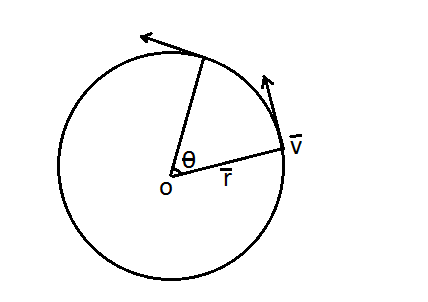
What is the value of linear velocity? If
Answer
479.4k+ views
Hint: When a body moves in the angular way i.e. circular motion and rotatory motion, with constant speed, it’s direction changes continuously so the angular velocity of body changes with respect to time, hence it has a linear velocity which is we are going to find. By remembering that it is a velocity not the speed because in uniform circular/rotational motion the speed remains constant. The linear and angular velocities both are vector quantities.
Formula used: Relation between linear velocity and angular velocity-
Where
Complete step by step solution:
The linear velocity of any rotating body is defined as the cross product of the angular velocity and the radius of path. In this question the angular velocity and the radius of path, in which the body is moving is given as –

We know from the relation of linear velocity and angular velocity
Hence, the linear velocity of the body is
Additional Information: The magnitude of linear velocity is
Angular velocity = the rate of change of angular displacement with respect to time is called angular velocity. And denoted by
Angular acceleration = the rate of change of angular velocity with respect to time is called angular acceleration. And denoted by
Angular acceleration is always changing with the change of direction.
Note:When we find the cross product of
Where
Formula used: Relation between linear velocity and angular velocity-
Where
Complete step by step solution:
The linear velocity of any rotating body is defined as the cross product of the angular velocity and the radius of path. In this question the angular velocity and the radius of path, in which the body is moving is given as –

We know from the relation of linear velocity and angular velocity
Hence, the linear velocity of the body is
Additional Information: The magnitude of linear velocity is
Angular velocity = the rate of change of angular displacement with respect to time is called angular velocity. And denoted by
Angular acceleration = the rate of change of angular velocity with respect to time is called angular acceleration. And denoted by
Angular acceleration is always changing with the change of direction.
Note:When we find the cross product of
Where
Latest Vedantu courses for you
Grade 11 Science PCM | CBSE | SCHOOL | English
CBSE (2025-26)
School Full course for CBSE students
₹41,848 per year
Recently Updated Pages
Master Class 11 Economics: Engaging Questions & Answers for Success

Master Class 11 Business Studies: Engaging Questions & Answers for Success

Master Class 11 Accountancy: Engaging Questions & Answers for Success

Master Class 11 English: Engaging Questions & Answers for Success

Master Class 11 Computer Science: Engaging Questions & Answers for Success

Master Class 11 Maths: Engaging Questions & Answers for Success

Trending doubts
State and prove Bernoullis theorem class 11 physics CBSE

1 ton equals to A 100 kg B 1000 kg C 10 kg D 10000 class 11 physics CBSE

State the laws of reflection of light

One Metric ton is equal to kg A 10000 B 1000 C 100 class 11 physics CBSE

Difference Between Prokaryotic Cells and Eukaryotic Cells

1 Quintal is equal to a 110 kg b 10 kg c 100kg d 1000 class 11 physics CBSE




